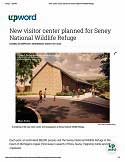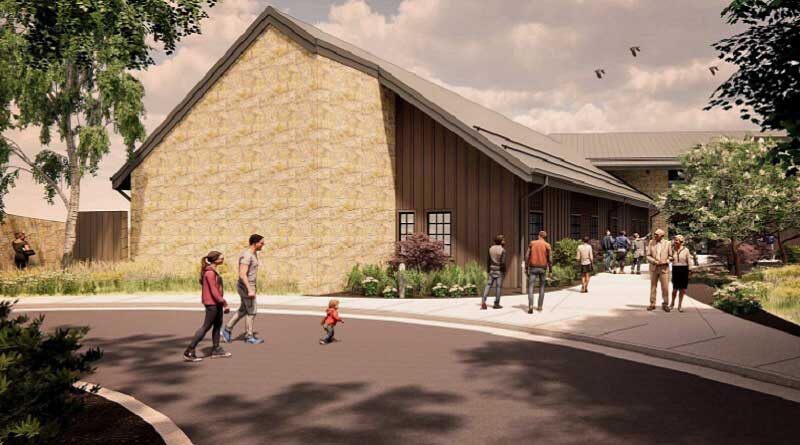New visitor center planned for Seney National Wildlife Refuge

By Dianna Stampfler
Each year, an estimated 88,000 people visit the Seney National Wildlife Refuge in the heart of Michigan’s Upper Peninsula in search of flora, fauna, migratory birds and other creatures. Visitors this year will find parts of this Schoolcraft County unit in a bit of disarray as a series of projects are underway to improve access and the overall educational experience for generations to come.
The U.S. Fish and Wildlife Service announced last spring that the Seney National Wildlife Refuge was the recipient of Great American Outdoor Act Funds in the amount of $12.5 million. According to Sara Giles, Visitor Services Manager, the funds are being directed toward four main projects:
- New combined Visitor and Headquarters building
- Marshland Wildlife Drive and Fishing Loop Bridge and Water Control Structure Repairs
- Show Pool Site Rehabilitation and Improvements
- Pine Ridge Nature Trail Improvement Project
The new Visitor Center and Refuge Headquarters will replace the previous office building – a 1930s-era converted garage to be demolished next month – and the 1964 visitor center that was razed last year. The groundbreaking for this new facility will be held on May 10; no completion date is currently available.
“It will have offices, restrooms, exhibits, a small movie theater and a multi-purpose room which will service as a meeting space and classroom,” says Giles.
A temporary Visitor Center will operate this season between May 16 and October 20 (Tuesdays through Saturdays from 9am to 4pm, excluding federal holidays) at 1986 Manistique River Road (CSR 436) in Germfask, about 6 miles south of the Refuge entrance road.
The Pine Ridge Nature Trail project is still in the final planning stages, but work will be done in conjunction with the building construction. Giles notes the Show Pool Shelters, with a new outhouse, with a reconfigured parking lot and road, will be open for the 2023 season (although limited work will be done throughout the summer which may result in occasional closures).
“The bridge project is nearly wrapped up,” Giles says. “As soon as the snow melts the contractors will return and complete the repairs and we expect that we will be able to open the Marshland Wildlife Drive and Fishing Loop on time this year. We will make an announcement as soon as the bridge project is complete (April or early May).”
Like other national sites, the Seney Refuge successfully operates in part due to an active volunteer base which donates thousands of hours of their time. Key among these efforts is The Friends of the Seney National Wildlife Refuge (a 501(c)3 non-profit with about 150 members). The mission of this group is to support refuge activities and connect people to the resources found throughout the refuge. Relying on member dues, donations, grants and funds raised from the operation of the Marshland Nature Store, the Friends continually reinvests in the refuge with a variety of educational, recreational and research activities including Youth in the Outdoors and Children’s Fishing Day as well as college internships.
“The Friends have been strong supporters of the Seney Refuge for 35 years and we are very excited to be a part of the improvements coming to the refuge,” says Bill MacLachlan, Friends’ president. “When completed, the project will result in much needed maintenance to the refuge infrastructure, and a modern visitor center facility with many new exhibits that will enhance visitors’ understanding of refuge wildlife and habitat. We are so grateful to our members, who have generously supported a $100,000 gift to be used for educational exhibits at the new Visitor Center.”
The Seney National Wildlife Refuge, the largest natural site of its kind in the Great Lakes region, was established in 1935 as part of Franklin Delano Roosevelt’s Works Progress Administration (WPA) initiative, at the request of the Michigan Conservation Department.
Named for George Ingraham Seney of New York, the town itself became a railroad stop in 1881 as the Duluth, South Shore and Atlantic line passed through between St. Ignace, in the Straits of Mackinac, and Marquette, along the Lake Superior shoreline. Seney’s population eventually grew to 3,000 and the town quickly gained a reputation as a rough and tumble locale full of lumberjack legends, bar room brawls and even scandalous places of ill repute. Internationally acclaimed author Ernest Hemingway wrote about Seney in his posthumously published collection The Nick Adams Stories inspired by a noted trip there in 1919 at the age of 20. An historical marker stands along the riverbank at the rustic Fox River State Forest Campground just seven miles north of M-77 – the real site for the classic “Big Two Hearted River”.
Originally carved by glaciers, the white pine forests around Seney were heavily logged leaving nothing much behind; the area ultimately became known as the Great Manistique Swamp. No longer suitable for farming and other commercial ventures, the marshes, bogs, swamps and forests turned out to be ideal for wildlife to live and breed. Pieced together over the years, the refuge now encompasses 95,238 acres – including the 25,150-acre Seney Wilderness Area with its Strangmoor Bog National Natural Landmark (one of the southernmost undisturbed stringed bogs in the nation), Whitefish Point Unit and Harbor Island National Wildlife Refuge just north of Drummond Island. Collectively, the refuge is now home to over 200 species of birds, 20 species of fish, 22 species of reptiles and amphibians, 50 mammal species and more than 420 plant species.
Dianna Stampfler has been writing professionally since high school. She is the president of Promote Michigan and the author of “Michigan’s Haunted Lighthouses” and “Death & Lighthouses on the Great Lakes”, both from The History Press.

